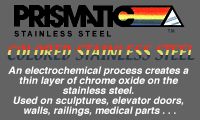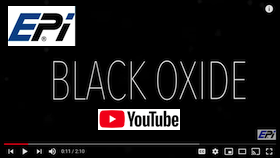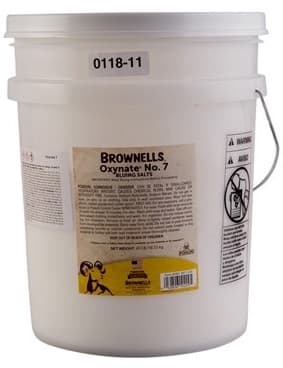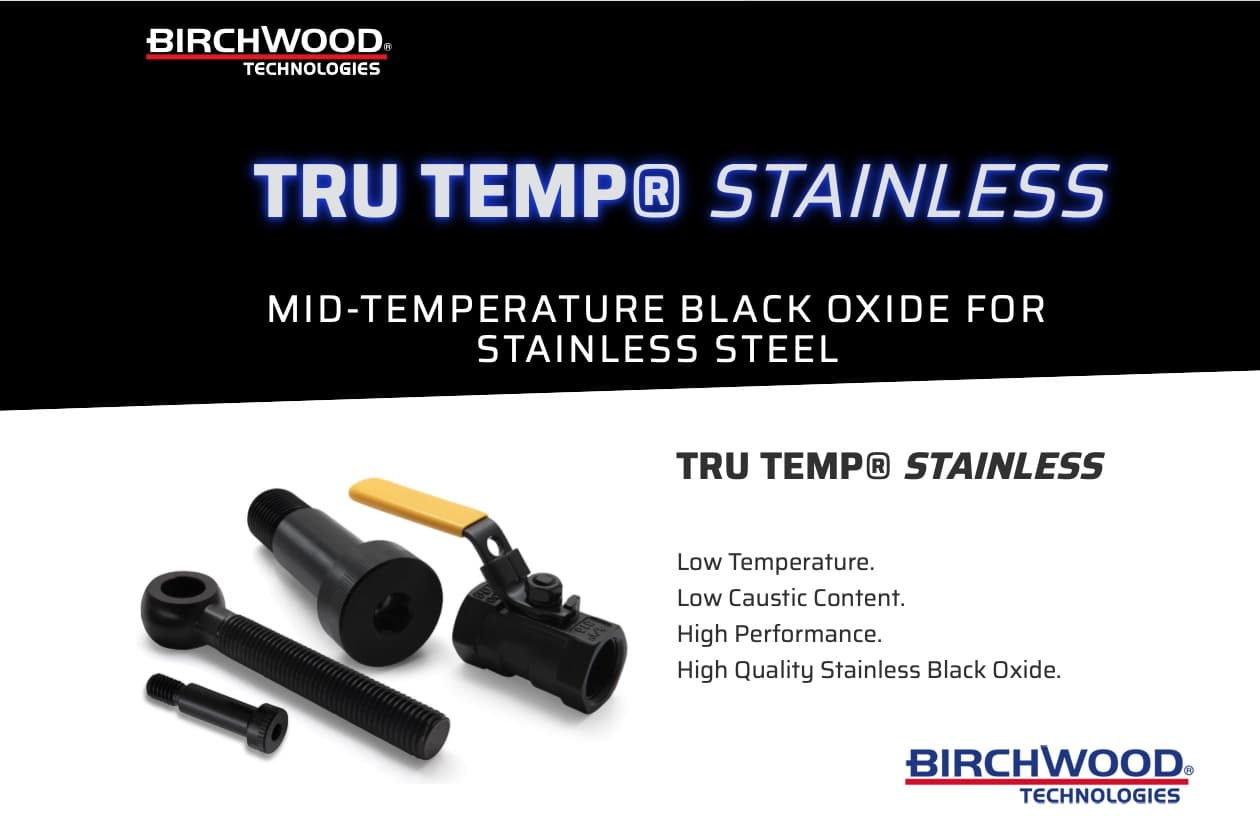
-----
Browning/Blackening stainless steel: black oxide, chemical dip, PVD, electroplating?
Q. I want to achieve aesthetic browning of AISI 316L and AISI304L steel by using a furnace. I have found, that at the temperature of 500 °C (930 °F for American friends), those alloys are turned beautiful golden color. However, there's an issue with the finish, as the surface is usually covered with sharp edged brown stains, which ruins the finish. Here's the procedure I used:
1. Using a 10 mm precision AISI316L tube
2. Polished the surface on a lathe with 400 grade sandpaper using isopropyl alcohol as a medium (also tried with regular coolant and water to the same effect)
3. Polished the surface again with 1000 grade sandpaper
4. Wiped out the surface clean with a dustless wipe and demineralised water
5. I cut out the tube on a lathe and transferred to a tank containing isopropyl alcohol, without touching the surface
6. I rinsed the tube with deionised water
7. I seasoned the tube in 75% phosphoric acid for 24 hours
8. I rinsed the tube in deionised water again
9. I put the tube to a vacuum dryer at 100 mbar and 60 °C (140 °F) for 5 hours
10. I put the tube into a clean muffle furnace with PID temperature control with tested setup that avoids overheating through oversteer.
11. I turned on the furnace and let it reach destined temperature over the course of 1 hour to avoid uneven heating
12. I turned the furnace off and left the sample overnight to cool down slowly
Unfortunately, the sample comes out with sharp edged brown stains. I have also tried this procedure without the acid etching, with different machining process (turning 2 mm off the metal surface to make sure i've reached a clean layer) and even with different furnaces. I have used analytics grade purity reactants and it still seems to have those impurities causing the dirty final look. What may be the root cause and how can I redeem the surface from being stained over the course of my heat treatment? This stuff is not letting me sleep at night.
- Warsaw, Poland
November 27, 2022
A. Hi Chris. Isopropyl alcohol and acids are "sort of" cleaners, but not quite. Is your tube "water break free" when you pull it out of the deionized water in step 8? If not, before searching further for causes I think you should make sure it's clean by inserting step 5A, scrubbing with a scrub brush
⇦ on
eBay or
Amazon [affil link] and wet powdered pumice
⇦ on
eBay or
Amazon [affil link] .
Luck & Regards,

Ted Mooney, P.E. RET
Striving to live Aloha
finishing.com - Pine Beach, New Jersey
Ted is available for instant help
or longer-term assistance.
⇩ Related postings, oldest first ⇩
Q. Could you please direct me to books or review articles where I could get some information on protective/decorative coating on stainless steel. Further, is this coating good enough to prevent corrosion in salt water? Is it very expensive? Thanks!
Mukesh Bheda1996
A. Dear Mukesh,
My company is a manufacturer's agent that specializes in finishes for stainless steel (type 304/316). We provide Titanium sputtered (vacuum deposition) of titanium oxide onto stainless steel. Colors available are: Gold, Black, Bronze & Blue. Titanium oxide plated sheets are durable, abrasive resistant, will not fade and do not require lacquer coatings replaced every 2-3 years. Because the base material is type 304/316 stainless, the sheets will not corrode or rust, not even near salt water environment (where, by the way, we recommend Type 316).

Michael Liu Taylor
specialty stainless steel distributor - Dallas, Texas
A. Hi, Mukesh. In addition to sputtering with titanium, stainless steel can also be electroplated with black materials like black chromium; it can be black oxided, although this may not offer enough corrosion resistance; it can be anodized into black and other colors. And, of course, it can be painted or powder coated.
Salt water is very corrosive and I think it would need to be a minimum of grade 316. Good luck.
Regards,

Ted Mooney, P.E.
Striving to live Aloha
finishing.com - Pine Beach, New Jersey
Ted is available for instant help
or longer-term assistance.
Black oxide on stainless steel is inconsistent
Q. I am getting poor results from black oxide on 303 stainless. The colors are not uniform. Is this a process problem or would a different stainless steel be better suited for this process?
Pat kaneend user - apopka, Florida
2005
Q. I am looking for a good method to do blacking on 316 SS. Does anyone have a good method?
Greg Bolduc- Muskegon, Michigan, USA
2005
A. Black Oxide coatings on stainless steel are common. Type 303 has a high sulfur content that seems to interfere with the black iron oxide (Fe3O4) formation, but the rest of the 300 series can be coated to MIL-DTL-13924 [⇦ this spec on DLA], Class 4. (I like 316 or 316L over the 304 alloy.) Remember that black oxide coating is not prescribed for corrosion protection. If you're not going to paint it, use a water displacing preservative coating such as MIL-PRF-16173 [⇦ this spec on DLA, grade 3 or 4. The process details are found in MIL-HDBK-205A.
Get the military specs - they are free (you've already paid for them in taxes :). Google "Assist Quicksearch" and put in the numeric part of the spec in the "Document Number" box.
Allan LangMaterials Engineer - Pensacola, Florida, USA
January 15, 2008
A. As an alternative to trying to formulate your own black oxide process for stainless steel, proprietary processes are available from companies like EPI / Electrochemical Products Inc. [a finishing.com supporting advertiser] and others.
opinion! Allan is right; our government does indeed tax American finishing shops and then spend some of that tax money making MIL specs available for free to their offshore competitors, both assuring that multinational companies are rewarded rather than punished for off-shoring, and that foreign companies can get a free leg up on American small business :-(
That's not the actual intent of course; the intent is probably to generously reimburse beltway bandits for their campaign donations :-)

Ted Mooney, P.E.
Striving to live Aloha
finishing.com - Pine Beach, New Jersey
Ted is available for instant help
or longer-term assistance.
FDA acceptable blackening of stainless
Q. I'm having difficulty trying to get a black finish on 400 series stainless steel. This is for an FDA acceptable device for body contact. I've tried sulfuric / sodium dichromate to no avail. Any advice would be truly appreciated.
Jim Transuestamping company - Somerset, New Jersey
1997
A. Have your tried titanium nitride colored stainless? Physical vapor deposited onto type 300 or 400 series?
Any MSDS data from your examinations/evaluations would be appreciated.
Regards,

Michael Liu Taylor
specialty stainless steel distributor - Dallas, Texas
A. Hi Jim,
I had experience with a black finish on stainless steels. I believe that sulfuric acid/dichromate solutions can help you achieve the goal if you use proper ratio of sulfuric acid to dichromate, high concentration and high temperature, and enough immersion time. But be very careful, this operation is quite dangerous.
Ling Hao- Grand Rapids, Michigan
A. We frequently put what we call "black stain marks" on type 300 & 400 stainless steels by local spot annealing with laser. The result is an indelible jet black mark (it looks just like 100% black ink) 0.001" - 0.002" into the metal without any visible erosion of the surface (visible under 30X magnification). I recognize that rastering a surface with a 0.004" dia. spot isn't an economical process for areas of any size (although Penn State's Advanced Research Center (ARC) has pioneered work with laser cladding of large areas using just such a rastering technique) but it suggests that there may be a non-chemical heating method for obtaining this finish.
Josh Drexlerlaser systems mfgr. - Pepperell, Massachusetts
Simple dipping only
Q. Sir : Just like to ask what will be the best chemical combination we can use for stainless steel blackening thru dipping.
victor manicad1998
A. There is a product available from Heatbath called PX5; it is a blackening salt designed specifically for stainless steel. Good luck.
Jeff Millsmetal finishing shop - Gorham, Maine
Q. Hi,
I am also looking for a method of blackening on stainless steel, but don't want the super aggressive/nasty ones that involve high temperatures or dangerous chemicals.
What success did/have you had with your query?
Regards,
Chris Burgess- Brisbane Australia
1998
A. Hi Chris and Victor,
I'm not familiar with Heathbath's PX 5 product (though I'm sure it's a good one). But I know Hubbard Hall has a room temperature Black that works on most stainless steels.
Good Luck,
Mike Horton- Brooklyn, New York
![]() Hi Mike,
Hi Mike,
I am interested in literature regarding stainless steel blackening. It is greatly appreciated if you would like to let me know where I can find them. Thanks.
Ling Hao- Grand Rapids, Michigan
Anodizing stainless steel to blacken it
Q. I am looking for an economical scratch resistant black coating process to be applied on type 400 series stainless steel. Process should not be overly aggressive and no worse in terms of processing than hot black oxide.
John Lang- Hartford, Connecticut
1998
A. John
We color stainless steel electrochemically and achieve a black color on 400 series stainless. The coating is a very thin chrome oxide (.000005" thick).adv.
Please feel free to contact me for more information.
B&M Finishers / Prismatic Stainless Steel
Kenilworth, New Jersey

Blackening in small / low volume
(affil links)

free pdf is currently available from academia.edu
Q. I am blackening 304 stainless steel with a formula suggested in the Metal Finishing Guide Book (180 parts Sulfuric, 200 parts water, 50 parts potassium dichromate at 210 °F.) The parts are prepared by bead blasting, alkaline cleaning, and a 50% HCl dip.
My parts, mostly nuts, bolts, and screws, have a red or purple hue that can be removed with fine 00 steel wool ⇦ on eBay or Amazon [affil link] but take up to twelve hours to process. Can anyone suggest how I might eliminate the colored hues, reduce process time, and produce a darker black. Proprietary preparations are sold in quantities that are far beyond my needs and resources.
Walt Puryear- Athens, Georgia
2001
A. Maybe this solution can help: 50 grams H2SO4 200 grams sodium thiosulphate ⇦ on eBay or Amazon [affil link] 1 liter water, 30 °C temp.
Goran Budija- Cerovski vrh Croatia
2004
A. Hi Walt. If the volume is too low to interest a local distributor of plating chemicals, it's also possible to buy in small quantities from consumer-oriented companies like Brownells.
Regards,

Ted Mooney, P.E.
Striving to live Aloha
finishing.com - Pine Beach, New Jersey
Ted is available for instant help
or longer-term assistance.
November 2013
Is 'black oxide' the right name?
Q. Is the process by which SS is darkened to a black or grey called "black oxide", or is it called other things, such as "acid-washed"? Thank you.
Chris Lawrencejob supervision - Boston, Massachusetts
2006
A. Black oxide is just that - chemical conversion of IRON to the black oxide form of rust (as opposed to the all too familiar red form). It has an appealing black color, is fairly well adherent to the basis metal, and adsorbs post treat preservatives such as oil quite well.
This should be compared versus a black etch smut that forms upon immersion of certain stainless steels in various acid media such as hot sulfuric or hot muriatic (hydrochloric). This black smut is non-adherent and non-uniform in appearance. They are obviously not the same!

Milt Stevenson, Jr.
Plating shop technical manager - Syracuse, New York
A. Black oxide conversion coatings for steel are formed in alkaline solutions containing strong oxidizers (nitrite/nitrate).
The chemical reaction for the formation of magnetite, black oxide, is as follows: The iron for the blackening process is contributed by the base metal. Byproducts of the blackening reaction are colloidal iron and carbonates, which are removed from the bath by de-sludging and skimming.
Black oxide coatings do not change the dimensions of the parts blackened. The coating will not chip or peel and acts as an absorbent to hold oils or waxes.
The black oxide bath is simple to operate. A rolling boil should be maintained at 150 °C with additions of water or blackening salts. Cleaned parts are immersed from 5-20 minutes in the bath and then rinsed thoroughly. Finally, a rust preventive coating is applied.
The black oxide coating itself does not afford much corrosion protection (only 1-2 hours salt spray exposure); although the rust preventive top coat is absorbed by the black oxide and can achieve up to 100 hours of salt spray exposure depending on the product used.

V. G. Rajendran
- Trichy, Tamilnadu, India
Terminology:
Black Oxiding = Blackodizing
The process usually called 'Black Oxiding' in the USA is often called 'Blackodizing' in India
Q. CAN WE DO BLACKODISING ON SS431 COMPONENTS.
IF YES,
PLEASE GIVE ME PROCESS.
EMPLOYEE - MUMBAI, MAHARASHTRA, India
November 8, 2008
A. Blackening on SS can be done on various methods. But all depends on the usage and its utility and the purpose and the environmental condition. If the answer is submitted, we can suggest many blackening processes.
Chandramanipg- Bangalore, Karnataka, India
Is Ebonol suitable for stainless steel?
Q. My production is running blackening on 302 standard steel parts. Now, I'm facing unplated, bending test fail and erase test fail issues. I'm using Ebonol M-22 as my blackening solution and 50% HCl as my pre-treatment process.
I am going to use pure HCl (without mix with H2O) to doing pre-treat for my standard steel parts as to reduce my NC of finished goods. Any good suggestions on my process?
Well, our production is now facing a lot of quality issues on 302 steel parts. Any good suggest on how to reduce my NC parts? Or any good process to replace my current blackening process?
plating - KL, Malaysia
2005
Q. Is it possible to use black Ebonol on 303 stainless?
Abbie Moran- Littleton, Massachusetts, USA
January 16, 2013
A. Hi. Last I heard Ebonol was for copper and zinc and alloys of the same, such as brass, and nickel. But I think you folks need to contact the manufacturer (Enthone) since Ebonol is a trade name for a proprietary blackening process and there may be a number of different formulations.
But Kaka, don't increase the strength of your HCl -- 50% is already probably too much, and not great for stainless steel. I suspect that the metal is simply dirty. You need to do hot alkaline cleaning until you have a waterbreak-free surface after rinsing before you do the acid dip. Good luck.
Regards,

Ted Mooney, P.E.
Striving to live Aloha
finishing.com - Pine Beach, New Jersey
Ted is available for instant help
or longer-term assistance.
November 2013
What causes occasional brown areas?
Q. We are blackening stainless steel (302 & 304) parts in barrels.
The process used is double degreasing (water based), rinsing, pickling (hydrochloric acid - 15%), double rinsing, pickling (nitric acid 15%), double rinsing, pre blackening (in eco rinse of blackening) and blackening (caustic soda ⇦liquid caustic soda in bulk on
Amazon [affil link]
& sodium nitrate
⇦ on
Amazon [affil link]
) at 125 °C.
Parts are rinsed in a three stage rinsing and finally immersed in an oil emulsion.
All of this is performed fully automatic with controlled movement and precise temperature controlled process steps.
Nevertheless, we detect from time to time a few batches that contain parts with some areas that are brownish instead of black. This becomes more visible after 24 hours.
Does anybody knows the origin of this problem?
Another question is how to pretreat 4xx series of stainless steel.
The current process is not suitable as parts come out completely blank.
Thanks in advance for any comment
- Belgium
February 19, 2013
A. Hi Guy. You say that you have a "precise temperature controlled process", but does that mean you turn heaters on and off to maintain temperature? Not good enough!
As Rod Henrickson has noted several times on this site, you must never attempt to modulate the temperature by controlling the heat input; rather you must maintain a rolling boil and add water if the temperature is too high and evaporate it if too low ... because the solution must always be at a rolling boil or you will get brown parts. You must control the temperature by controlling the concentration and thus the boiling temperature, not by modulating the heat input.
Regards,

Ted Mooney, P.E.
Striving to live Aloha
finishing.com - Pine Beach, New Jersey
Ted is available for instant help
or longer-term assistance.
Q. We control the temperature of the blackening bath through two independent heaters with a different setpoint. Recent logging shows evidence that the variations remain between ± 1.5 °C. The parts are pre-heated through a heated ecorinse at ± 65 °C. We intend to eliminate the remaining 2,8 % of non conformities by dosing water to the blackening bath. Do you know a sensor capable of measuring the boiling point?
Thanks in advance for any help!.
- Kuringen, Belgium
A. Hi. Sorry, I don't know of an instrument that can detect the boiling point of a liquid. That is a good question, though -- obviously it would be nice to not madly pour heat into a solution beyond the amount necessary to maintain a rolling boil.
But in the meanwhile, remember to not use those thermostats to modulate the heaters -- instead, the solution must be kept at a rolling boil, and you must add water if that rolling boil temperature is higher than your spec, and stop adding water if that rolling boil temperature is lower than your spec. Good luck.
Regards,

Ted Mooney, P.E.
Striving to live Aloha
finishing.com - Pine Beach, New Jersey
Ted is available for instant help
or longer-term assistance.
Q. Dear all,
This is my first time asking a question on this forum, I hope you all can help me on this.
I have been blackening little pieces of 304 stainless steel sheet #4 finish, by burning with a little propane torch. Some get really black, and some take forever and only reach a grey. I would like to mention that the ones reaching the black color are of a different sheet than the ones reaching the grey color. And I am sure these are both 304, yet not sure if one of these two sheets is a 304L.
Would the low carbon sheet make any difference on the burning procedure?
and what would be the best way to blacken stainless steel?
Thanks very much for your help.
Elias Mouawad
- Willow Grove, Pennsylvania, USA
November 28, 2013
A. Chemically Blackening Stainless is not easy. It is usually done in an Alkaline salt bath at elevated temperatures (230 °F? if I recall) as well as some cleaning before hand. Heatbath used to sell a line of product for this purpose.
There are room temperature systems out there to blacken steel, but these are for carbon steel, not stainless.
- Cedar Rapids, Iowa, USA
A. Try next download free booklet, there you can find some black finishes for stainless steel :
attachments.wetpaintserv.us/ZLSnLKosv0l3CnE9hGDi7w488720
Hope it helps and good luck!
- Cerovski vrh Croatia
Ed. note Jan 2017: Although wetpaintserv.us was a legitimate site when Goran posted this, it is currently a malware site. DON'T GO THERE!! Goran has been kind enough to upload his booklet to https://www.finishing.com/library/budija/kembojen2025.pdf.
Need black finish on 303 stainless steel with little to no build up
Q. I have 303 stainless steel parts that fit in a tight area and I need to blacken these parts they have a 2-56 threaded hole and a thru hole that neither can get clogged up
don baker- kentucky
March 5, 2014
A. Hi Don. We attached your inquiry to a thread which introduces many different ways of blackening stainless steel. But of these, I think only sputtering or black oxiding would meet your tolerance requirements, and sputtering will not get into those holes and threads.
Allan Lang notes that black oxiding of 303 stainless can be problematic, so I think you should contact a supplier of proprietary black oxide processes and see what they suggest. Best of luck.
Regards,

Ted Mooney, P.E.
Striving to live Aloha
finishing.com - Pine Beach, New Jersey
Ted is available for instant help
or longer-term assistance.
Q. Hi. We need to oxidise stainless steel small parts just like jeans buttons.
We normally using chemical name Hypo, but that is too hard chemical. After wash it left its effect and after some time stainless steel start releases rust however we use lacquer on the surface.
So is there any other process or formula to oxidise SS?
- Karachi. Pakistan
August 11, 2016
? Hi Adeel. When you say you need to 'oxidize' stainless steel, I'm thinking you want to blacken it through that oxidation process (black oxide). We appended your inquiry to a thread about blackening stainless steel, and several other applicable threads can be found with that search term. If you are not intending to blacken the stainless, please help me understand what you mean by oxidize.
Regards,

Ted Mooney, P.E. RET
Striving to live Aloha
finishing.com - Pine Beach, New Jersey
Ted is available for instant help
or longer-term assistance.
Q. Hello, Does Series 400 SS need a different pre treatment than that of 300 series SS, because I'm having trouble blackening 400 series parts. Thanks
Erick BustamanteMicro Procesos Industriales - Chihuahua, Chih, Mexico
December 20, 2017
Blackening stainless steel in the field
Q. Gents, We are installing a stainless steel weir edge around a decorative infinity pool. The client would like it to be black in color. It does not need to be perfectly consistent black necessarily. It is fairly large in size, approx. 60 feet by 35 feet rectangular and since it needs to contain water the fabricated sections would be field welded. Does anyone know of a process that could be field applied to blacken 316 stainless, that would withstand years of flowing chlorinated water?
Bob MortonDecorative Fountain Design and Installation - Orlando, Florida USA
May 2, 2018
Black Oxide 329 SS
Q. We are trying to apply a black oxide finish to 329 stainless. Customer requires zero dimensional change and needs a black non-reflective surface. Black Oxide is specifically called out.
Finish never gets beyond a gray-green and rubs off. No oil is applied. Parts cannot be blasted. Duplex stainless is something we have nitric passivated in the past but never attempted to black oxide.
Process is...
Hot alkaline cleaner
Cold water rinse
Sulfuric acid 13%
Cold water rinse
Px-5 15 minutes
Cold water rinse
All temps and times are in accordance with manufacturer's specs.
Any input would be greatly appreciated.
- Gorham, Maine USA
January 7, 2020
A. Hi Thomas. I would be surprised if 13% sulfuric acid has the required activating power to remove heavy oxides and expose the stainless steel. I'd probably focus on trying a more powerful acid. You could try activating a scrap part in hydrochloric acid or a tri-acid salt and see what happens.
Regards,

Ted Mooney, P.E. RET
Striving to live Aloha
finishing.com - Pine Beach, New Jersey
Ted is available for instant help
or longer-term assistance.
Q. We tried it at 50% HCl with soak times between 5 & 7 minutes and it didn't improve. I'm wondering if 329 is just too acid-resistant to activate properly for black oxide. I do appreciate your input.
Thomas Kane [returning]- Gorham, Maine USA [returning]
A. Hi again. Although black oxide lines do not usually have provision for electrocleaning, I wonder if, as an experiment, anodic electrocleaning would be useful before the HCl?
Regards,

Ted Mooney, P.E. RET
Striving to live Aloha
finishing.com - Pine Beach, New Jersey
Ted is available for instant help
or longer-term assistance.
A. Thomas,
Consider sending some sample parts to the (PX-5) manufacturer for processing. They should be able to help you dial in the process.
- Green Mountain Falls, Colorado
Readers: We have a dozen long threads about blackening stainless steel. Please search the site with "Black stainless" plus your specific search word if you didn't find your answer on this page.
Q, A, or Comment on THIS thread -or- Start a NEW Thread


